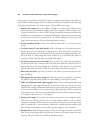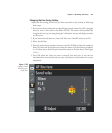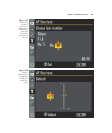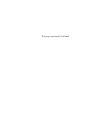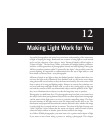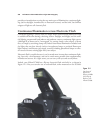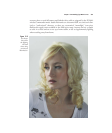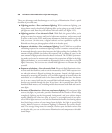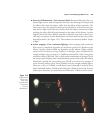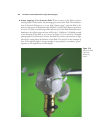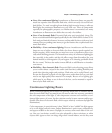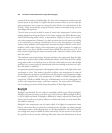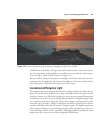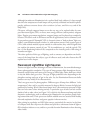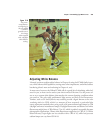There are advantages and disadvantages to each type of illumination. Here’s a quick
checklist of pros and cons:
■ Lighting preview—Pro: continuous lighting. With continuous lighting, you
always know exactly what kind of lighting effect you’re going to get and, if multi-
ple lights are used, how they will interact with each other (see Figure 12.2).
■ Lighting preview—Con: electronic flash. With flash, the general effect you’re
going to see may be a mystery until you’ve built some experience, and you may need
to review a shot on the LCD, make some adjustments, and then reshoot to get the
look you want. (In this sense, a digital camera’s review capabilities replace the
Polaroid test shots pro photographers relied on in decades past.)
■ Exposure calculation—Pro: continuous lighting. Your D7000 has no problem
calculating exposure for continuous lighting, because it remains constant and can
be measured through a sensor that interprets the light reaching the viewfinder. The
amount of light available just before the exposure will, in almost all cases, be the
same amount of light present when the shutter is released. The D7000’s Spot meter-
ing mode can be used to measure and compare the proportions of light in the high-
lights and shadows, so you can make an adjustment (such as using more or less fill
light) if necessary. You can even use a hand-held light meter to measure the light
yourself.
■ Exposure calculation—Con: electronic flash. Electronic flash illumination does-
n’t exist until the flash fires, and so can’t be measured by the D7000’s exposure sen-
sor when the mirror is flipped up during the exposure. Instead, the light must be
measured by metering the intensity of a pre-flash triggered an instant before the
main flash, as it is reflected back to the camera and through the lens. An alterna-
tive is to use a sensor built into the external flash itself and measure reflected light
that has not traveled through the lens. If you have a do-it-yourself bent, there are
hand-held flash meters, too, including models that measure both flash and contin-
uous light.
■ Evenness of illumination—Pro/con: continuous lighting. Of continuous light
sources, daylight, in particular, provides illumination that tends to fill an image
completely, lighting up the foreground, background, and your subject almost
equally. Shadows do come into play, of course, so you might need to use reflec-
tors or fill-in light sources to even out the illumination further, but barring objects
that block large sections of your image from daylight, the light is spread fairly
evenly. Indoors, however, continuous lighting is commonly less evenly distrib-
uted. The average living room, for example, has hot spots and dark corners. But
on the plus side, you can see this uneven illumination and compensate with addi-
tional lamps.
David Busch’s Nikon D7000 Guide to Digital SLR Photography398



